What Is the Name of the Makeup Worn with Hanfu? (Part 2)

In the previous article, we talked about makeup from the Pre-Qin period to the “goose yellow look” of the Wei, Jin, and Southern and Northern Dynasties. But with so many exquisite styles of makeup in the history of Chinese outfit, it’s impossible to cover them all.
What we’ve chosen to discuss is only a small part of the most renowned looks recorded in Chinese history. If there’s a chance in the future, we’ll continue to explore the diversity and beauty of Hanfu makeup in more detail ~
Ⅰ. Wei, Jin, and Northern & Southern Dynasties — Xue Yelai’s “Morning Glow Look”
In the Record of the Zhuang Lou Ji (《妆楼记》) by Tang dynasty writer Zhang Mi, there is a story about this look. One evening, Emperor Wen of Wei was reading under the lamplight when his palace maid Xue Yelai came to serve him tea. She accidentally bumped into a crystal screen, bruising her cheek. The mark resembled the fading glow of dawn (晓霞妆), and the emperor was so captivated by her appearance that he put his book aside and doted on her even more.
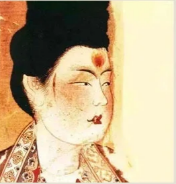
Other palace women, seeing Xue Yelai gain favor, quickly copied the look by painting crimson streaks on their cheeks with rouge, imitating the injury. They called this style the Morning Glow Makeup.
(Silkdivas tip: it’s okay to chase beauty, but please—no self-inflicted bruises!).
Ⅱ. Wei, Jin, and Northern & Southern Dynasties — Princess Shouyang’s “Fallen Plum Blossom Look”
Fallen Plum Blossom Look (落梅妆) Also known as Shouyang Makeup (寿阳妆). According to legend, Princess Shouyang, daughter of Emperor Wu of the Liu Song dynasty, once rested beneath the palace eaves. A gust of wind shook the branches of a plum tree, and a blossom fell onto her forehead. The damp petals left behind a delicate plum-shaped imprint.
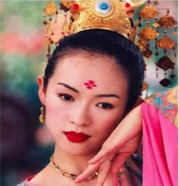
The palace women found the mark so charming that they began to imitate it. This gave rise to the fashion of painting or adorning the forehead with floral designs, later called hua dian (decorative forehead ornaments).
Ⅲ. Flourishing Tang Dynasty — Two Bold Red Looks (Peach Blossom Look & Drunken Blush Look)
During the Tang dynasty, makeup was known for its bold and striking use of rouge, covering large areas of the face. A softer version was called Peach Blossom Makeup (桃花妆), where the cheeks were lightly flushed, resembling peach blossoms in early spring.
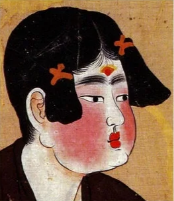
The most dramatic version, popular during the time of Yang Guifei, was known as Drunken Blush Look (酒晕妆). Rouge was applied not only to the cheeks but also heavily on the eyelids and even the ears, creating the impression of being tipsy. The process began with a layer of white powder, followed by thick rouge on the cheeks, giving a flushed, intoxicated look. This style was especially favored by young women, often paired with thin “moth eyebrows” and mianye (面靥) near the lips—an iconic Tang aesthetic.
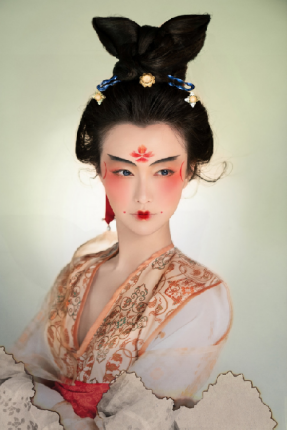
Women of that era were unapologetic in their pursuit of beauty. Their makeup was bold, extroverted, and extravagant. While to modern eyes it may seem overly heavy, it perfectly reflected the Tang dynasty’s love for opulence. Moreover, makeup was a privilege reserved for certain social classes, and wearing it was not only about beauty but also tied to status and cultural expression.
Ⅳ. Mid-Tang Dynasty — Dangerous Fashion Look
One striking style of the mid-Tang era was called Dangerous Fashion Look (时世险妆). Its features included sorrowful, drooping brows, lips painted dark with black pigment, faces dusted with ochre powder, and streaks of red across the cheeks. (The cover image of this blog post features a beauty in Chinese outfit wearing this exact makeup look.)
Many scholars of the time criticized this look, saying it symbolized the decline of the Tang dynasty, linking women’s beauty trends with social unrest. But women clearly disagreed—they refused to carry the blame for being “the cause of chaos.”

This ochre-style face paint actually came from Tibetan influence. On the Tibetan plateau, people often developed a natural flush due to the harsh environment, so they created a brownish cream from yak milk to protect their skin from the sun. Over time, this became known as the Tibetan Ochre Look. After the An Lushan Rebellion, when Tibetan forces entered Chang’an, the style spread and was adopted into Tang women’s makeup trends.
Ⅴ. Song Dynasty — “Tanyun Look”
By the Song Dynasty, under the influence of Neo-Confucianism (Cheng-Zhu school), women’s makeup shifted away from heavy, glamorous looks to a lighter, more natural style.

One of the most popular trends was called “Tanyun Look” (檀晕妆). The process began with a layer of white powder as a base, followed by a soft application of sandalwood-tinted blush. This blush, a pale pink powder, gave the effect of a natural flush—like rosy cheeks shining through fair skin. The result was a fresh, elegant look that mimicked a “no-makeup” makeup style centuries before the term existed.
Ⅵ . Song Dynasty — Pearl Facial Decorations (珍珠面靥)
Although Song Dynasty makeup leaned toward simplicity, women still valued refinement and elegance. At court, pearls were first used as facial adornments.
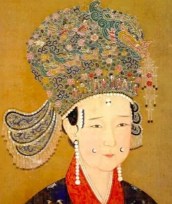
While noblewomen could afford pearls, common women often used alternatives such as gold foil, seashell inlays, flower petals, or small cutouts from plants.
Ⅶ. Ming Dynasty — Natural “Bare-Face” Look & the “Three Whites” Look (裸妆、三白法)
In the Ming Dynasty, women’s makeup emphasized brightness and vivid colors. Compared with the later Qing style, Ming women preferred lighter blush and more natural lip colors. Building on the Song era’s elegant minimalism, their look was similar to what we might call “natural hanfu makeup” today.
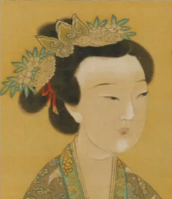
To enhance facial structure, they developed the “Three Whites” technique—highlighting the forehead, nose, and chin with pale powder to create a more dimensional effect.
Ⅷ. Qing Dynasty – Elegant Simplicity
During the Qing Dynasty, women’s makeup emphasized subtlety and restraint, with an overall focus on elegance and simplicity. Eyebrows were thin and slender, shaped like willow leaves; eye makeup was soft and understated; and pink-toned rouge was commonly used to highlight a delicate, gentle feminine look—quite a contrast to modern makeup’s emphasis on highlighter and contouring!
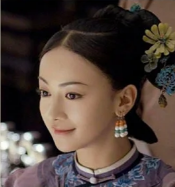
Classic Qing Dynasty makeup included: crimson lip makeup, willow-leaf thin eyebrows, three earrings per ear, and the “double bun” hairstyle.
X. Qing Dynasty – Crimson Lip Makeup
The popular “crimson lip makeup”(绛唇妆) of the Qing Dynasty, as seen in historical paintings, involved applying color only to the center of the lower lip (with the upper lip left bare). This style exuded softness and grace, aligning closely with the traditional image of an Eastern beauty.
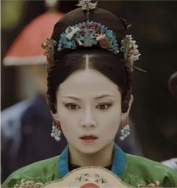
Some believe this look may have been influenced by the Han ethnic group’s “cherry-blossom mouth” aesthetic— a result of cultural fusion between the Manchu and Han peoples.
Summary
Makeup is a way to enhance your own charm and also a sign of respect for others. Which Chinese outfit makeup style is your favorite? Share your thoughts in the comments!
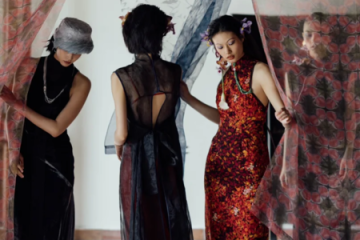
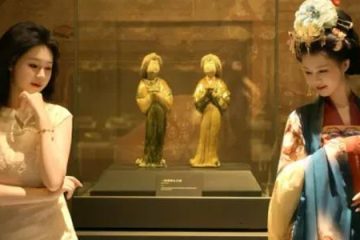
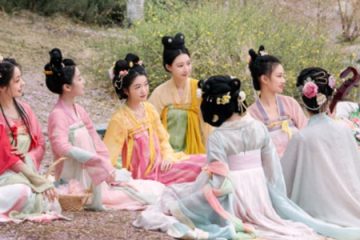
0 Comments